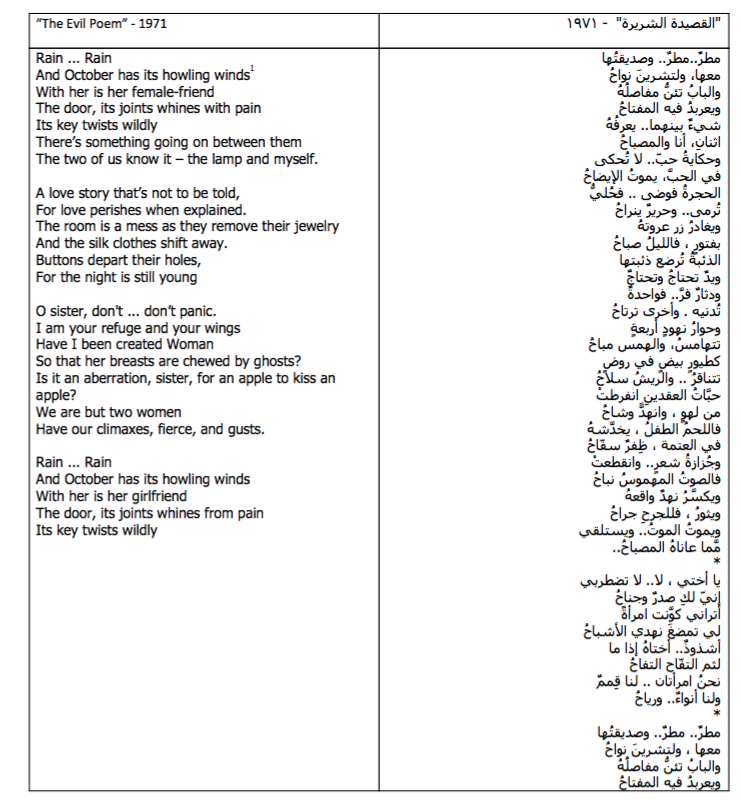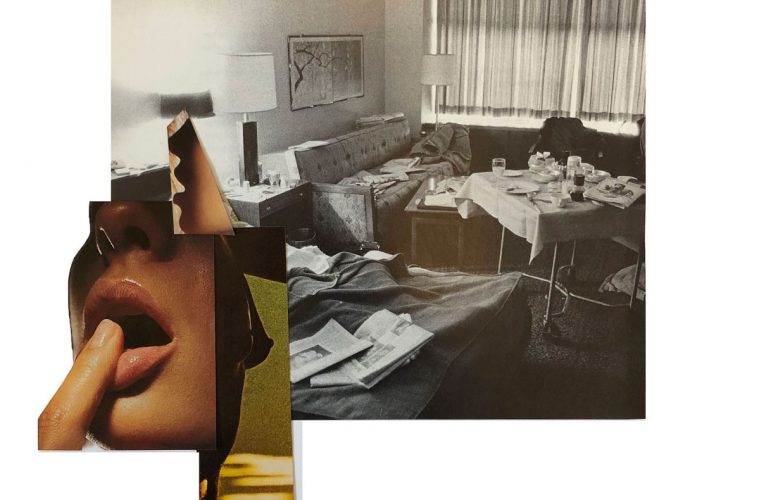Written by: A.W. Rahman
Art work by: Yasmine Diaz (scroll down for short bio)
Featured Image: There’s something between the two of them / شــيءٌ بينـهـمــا
collage on paper
Between diplomacy, poetry, and writing, Nizar Qabbani remains one of the most revered contemporary poets in the Arab world and is claimed by some to be a revolutionary “feminist” of his time. Qabbani explored controversial topics with his poetry ranging from themes of politics and public power to the private sexual awakenings of men and women. He was cited revealing that his main influencer was his 25-year-old sister who committed suicide as she was being forced to marry a man while she was in love with another. He did not understand why something as delicate and pure as love would be met with so much hate and aggression and due to these injustices, chose to write many of these poems in the voice of a woman.
In his descriptions of desire and love, his poems are written from the perspective of a heterosexual Arab man of the mid – 20th century. While the majority of these poems are dedicated to heteronormative relationships (heterosexual relations portrayed as the norm), one censored gem does not – “The Evil Poem”. “The Evil Poem” is a story narrated to the reader from the perspective of someone spying on two female lovers. The gender of the spy is unknown (possibly irrelevant to Qabbani as he spoke interchangeably from the perspectives of either the male or female gender). As a queer woman, reading this poem excited me but also led me to question whether Qabbani’s poem was a means of fetishization or representation. Fetishization is the act of making something the object of one’s sexual gratification. Whereas, representation is the act of description or portrayal of a group or individual in media, literature, art, film, music etc. Although the poem has been censored in the region it has made a sudden reappearance amongst the LGBTQIA+ community.
Feminist Literary Criticism
Today, academics and critics from different fields of study have developed techniques to reread and reconstruct meaning buried in the works of canon (socially recognized as high quality) literature and texts. For example, a feminist / queer studies scholar would reread the play Macbeth, written by Shakespeare, and ask themselves the following questions: In what unique way does my identity as a woman reconstruct my understanding of the character Lady Macbeth? In what way does this literary work implicitly portray or challenge patriarchy or male domination? How is language used to empower or oppress someone’s narrative / story or reality? In rereading literature from the perspective of an oppressed community, a reader attempts to bring to their reading their contextual reality, their identities and their truths to unearth those hidden stories from the past. This form of critical deconstruction and reconstruction of meaning is a means of political power in which the reader takes charge of something imposed upon them.
In order to do a literary criticism of “The Evil Poem”, one should not look far from the title itself. A title is a reader’s first taste to the author’s intentions and what could be more enticing than the taste of evil? Why does he call it “evil”? Is he saying it’s a type of love that is surrounded by an evil world? Is he saying the sexual act itself is evil? Finally, a thought that struck me was, does Qabbani believe the act of spying on these two is evil?

Stanza One: The Discovery
The poem begins on a rainy October night, as we are forcibly taking part in an unwarranted voyeuristic trespass into these two women’s private moment. Feminists have called this theory, the male gaze, in which an entitled heterosexual man’s pleasure is forced and fixed upon the subject and the audience is watching through his powerful gaze. The narrator and the audience become one, become the “I”. He is an I, that not only is a witness to the act along with “the lamp”, but one that, through his later descriptions, is fully aware of the subjective and passionate love of women. It’s almost as if Qabbani’s male power has been able to penetrate the secrets of the mysterious female “harem” and translate the secret love affair to the world. He comes to liberate these women by making their encounter palpable to the audience. For some, the act being described in a famous poet’s work is a great achievement for the LQBTQIA+ community: “it’s great that he risked starting a discussion”. While, we would argue, if the goal of the author was merely to start a discussion and not to fetishize sapphic love, then why did the author not use two men?
Stanza Two: The Act
In the eroticized and descriptive pornographic scene, Qabbani’s language describes, rather, imposes and regulates a description of lesbian love that is heteronormative. He describes a messy room with jewelry and silk (things attributed to femininity) being tossed around the curves and contours of very feminine bodies. The woman is described as a female wolf breastfeeding her partner wolf. There is a conversation between four breasts taking place, whispering in the night to one another like small white birds in a garden, pecking at each other delicately. This maternal imagery in the poet’s language is as though femininity is tied to maternity, childbirth, breastfeeding, because, to a cis-man’s heterosexual gaze, a woman’s sexual liberation and social presence at large, can only be perceived through these descriptors. It’s almost as if Qabbani’s phallic sexual presence must intercede, as, to him, without a man’s paternal function motherhood cannot exist and therefore this sexual act would be frivolous.
Now What?
So many members of the community hold on to this poem as a form of representation and recognition but we should never forget our power to create our own visibility. We should look to creating or supporting artistic revolutions today that do speak from the perspectives and realities of our community. The feminist theory, standpoint theory, argues just that – no one can truly know your experience but someone who has experienced it. This article was written with the hopes of providing the base to criticize literary works from a gendered and queer perspective and offering a variety of healthy examples of representation from past and contemporary works.
With a focus on gender, third-culture identity, and family, Yasmine Diaz works with collage, drawing, and mixed media on paper, to question and assert her unique experiences as a Yemeni-American and feminist. Born in Chicago to parents who immigrated from the highlands of Yafa, the Los Angeles-based artist uses compelling found imagery to juxtapose the opposing cultures she was raised within. Her work has been featured in Kolaj Magazine, the Albuquerque Museum of Art, and in the collections of the UCLA School of Public Affairs. You check her instagram account: Click here
References
Al-Ghafari, Iman. “The Lesbian Subjectivity in Contemporary Arabic Literature: ‘An Absent Presence’ Disciplined by the Gaze.” Al-Raida Journal (2012): 6-18.
O’Keeffe, P. and Pásztor, Z. Syrian Academics in Exile. New Research Voices: International Journal of Research from the Front-Line (2016): 1–162.
Parker, Robert Dale. How To Interpret Literature Critical Theory for Literary and Cultural Studies. Third ed., Oxford University Press, 2014.
Zimmerman, Bonnie, ed. Encyclopedia of Lesbian histories and cultures. Routledge, 2013.
Recommended Readings
Rusi Jaspal. Islam and Homosexuality. The Wiley Blackwell Encyclopedia of Gender and Sexuality Studies, (2016) :pages 1-7.
Amer, Sahar. “Naming to empower: Lesbianism in the Arab Islamicate world today.” Journal of lesbian studies 16.4 (2012): 381-397.
Amer, Sahar. Crossing Borders: Love between Women in Medieval French and Arabic Literatures. University of Pennsylvania Press, 2008.
Amer, Sahar. “Medieval Arab lesbians and lesbian-like women.” Journal of the History of Sexuality 18.2 (2009): 215-236.
Massad, Joseph A. Desiring arabs. University of Chicago Press, 2008.

